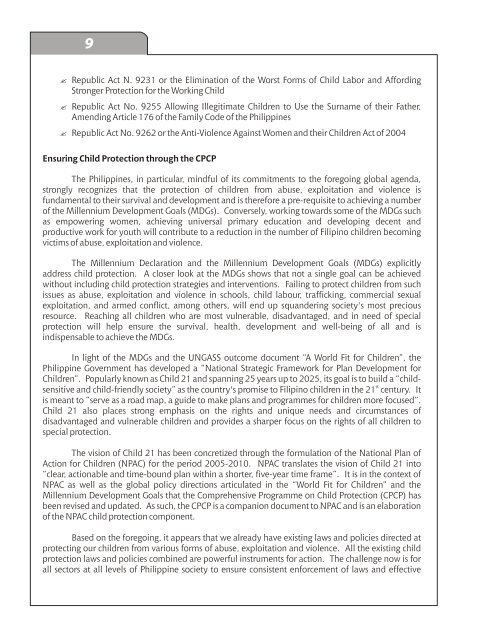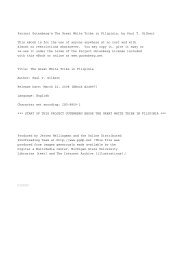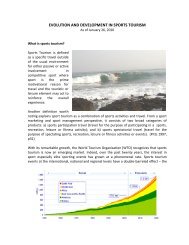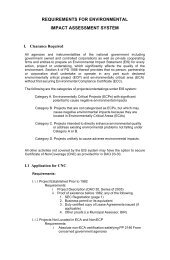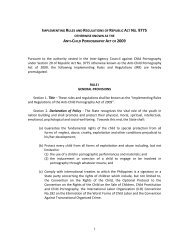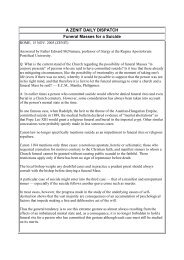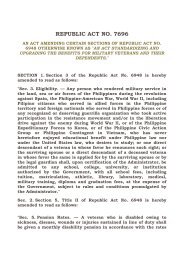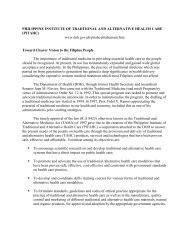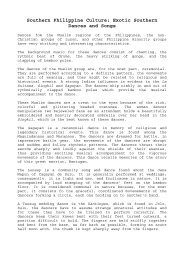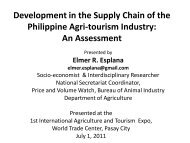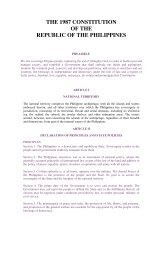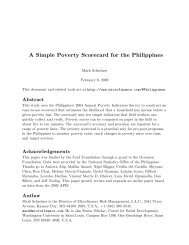protecting filipino children from abuse, exploitation and violence
protecting filipino children from abuse, exploitation and violence
protecting filipino children from abuse, exploitation and violence
You also want an ePaper? Increase the reach of your titles
YUMPU automatically turns print PDFs into web optimized ePapers that Google loves.
9<br />
?Republic Act N. 9231 or the Elimination of the Worst Forms of Child Labor <strong>and</strong> Affording<br />
Stronger Protection for the Working Child<br />
?Republic Act No. 9255 Allowing Illegitimate Children to Use the Surname of their Father,<br />
Amending Article 176 of the Family Code of the Philippines<br />
?Republic Act No. 9262 or the Anti-Violence Against Women <strong>and</strong> their Children Act of 2004<br />
Ensuring Child Protection through the CPCP<br />
The Philippines, in particular, mindful of its commitments to the foregoing global agenda,<br />
strongly recognizes that the protection of <strong>children</strong> <strong>from</strong> <strong>abuse</strong>, <strong>exploitation</strong> <strong>and</strong> <strong>violence</strong> is<br />
fundamental to their survival <strong>and</strong> development <strong>and</strong> is therefore a pre-requisite to achieving a number<br />
of the Millennium Development Goals (MDGs). Conversely, working towards some of the MDGs such<br />
as empowering women, achieving universal primary education <strong>and</strong> developing decent <strong>and</strong><br />
productive work for youth will contribute to a reduction in the number of Filipino <strong>children</strong> becoming<br />
victims of <strong>abuse</strong>, <strong>exploitation</strong> <strong>and</strong> <strong>violence</strong>.<br />
The Millennium Declaration <strong>and</strong> the Millennium Development Goals (MDGs) explicitly<br />
address child protection. A closer look at the MDGs shows that not a single goal can be achieved<br />
without including child protection strategies <strong>and</strong> interventions. Failing to protect <strong>children</strong> <strong>from</strong> such<br />
issues as <strong>abuse</strong>, <strong>exploitation</strong> <strong>and</strong> <strong>violence</strong> in schools, child labour, trafficking, commercial sexual<br />
<strong>exploitation</strong>, <strong>and</strong> armed conflict, among others, will end up squ<strong>and</strong>ering society's most precious<br />
resource. Reaching all <strong>children</strong> who are most vulnerable, disadvantaged, <strong>and</strong> in need of special<br />
protection will help ensure the survival, health, development <strong>and</strong> well-being of all <strong>and</strong> is<br />
indispensable to achieve the MDGs.<br />
In light of the MDGs <strong>and</strong> the UNGASS outcome document “A World Fit for Children”, the<br />
Philippine Government has developed a “National Strategic Framework for Plan Development for<br />
Children”. Popularly known as Child 21 <strong>and</strong> spanning 25 years up to 2025, its goal is to build a “childst<br />
sensitive <strong>and</strong> child-friendly society” as the country's promise to Filipino <strong>children</strong> in the 21 century. It<br />
is meant to “serve as a road map, a guide to make plans <strong>and</strong> programmes for <strong>children</strong> more focused”.<br />
Child 21 also places strong emphasis on the rights <strong>and</strong> unique needs <strong>and</strong> circumstances of<br />
disadvantaged <strong>and</strong> vulnerable <strong>children</strong> <strong>and</strong> provides a sharper focus on the rights of all <strong>children</strong> to<br />
special protection.<br />
The vision of Child 21 has been concretized through the formulation of the National Plan of<br />
Action for Children (NPAC) for the period 2005-2010. NPAC translates the vision of Child 21 into<br />
“clear, actionable <strong>and</strong> time-bound plan within a shorter, five-year time frame”. It is in the context of<br />
NPAC as well as the global policy directions articulated in the “World Fit for Children” <strong>and</strong> the<br />
Millennium Development Goals that the Comprehensive Programme on Child Protection (CPCP) has<br />
been revised <strong>and</strong> updated. As such, the CPCP is a companion document to NPAC <strong>and</strong> is an elaboration<br />
of the NPAC child protection component.<br />
Based on the foregoing, it appears that we already have existing laws <strong>and</strong> policies directed at<br />
<strong>protecting</strong> our <strong>children</strong> <strong>from</strong> various forms of <strong>abuse</strong>, <strong>exploitation</strong> <strong>and</strong> <strong>violence</strong>. All the existing child<br />
protection laws <strong>and</strong> policies combined are powerful instruments for action. The challenge now is for<br />
all sectors at all levels of Philippine society to ensure consistent enforcement of laws <strong>and</strong> effective


